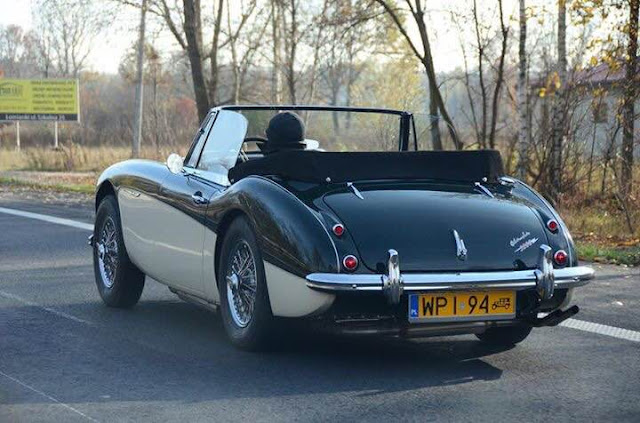Click on photos to enlarge - far superior rendition
 |
| The intrepid CCC crew assenbled at Pultusk |
A group of
hard core spankers turned out on a sunny but blustery Sunday for what might be
the last dry run this year. Ian turned out in an E-type full of kids, George
turned out in his modern 911, Jerzy represented the old school classics with
one of his Austin Healeys and Przemek did the young-timer thing in his Mazda
MX5. Yours truly wanted to come out in the M3 but the gearbox mounts are kaput
so the more sensible Volvo 480 turbo was aired instead.
Once again
kick off was at one of McD’s newer establishments, this time in Nieporet. Newer
means outside seating and a McCafe. The
kids were appeased with happy meals though I’m not sure who’s happier the kids
or the parents at the prospect of 10 minutes of silence. George had some sort
of breakfast stack while his wife did the cheesecake thing which lifts McD out
of the burger bar category in my books. Me, it’s the egg and bacon bap with a
coffee and using McD’s ‘2 for U’ deal it only cost 5zl. This means that for the
price of one Bristol dinner all the club members can have a breakfast.
But now the
trip. To reduce the risk of losing the fleet whilst in transit I’d set a
mid-point destination and given everyone a little map. By starting in
Nieporet we had no traffic lights to worry about. The simple route was R631
from Nieporet heading towards Modlin, hang a right onto the R632 heading
towards Debe/Plock then R571 towards Pultusk. Just over 50km’s and an easy hour
at as steady pace.
After years
of complaining about the state of Polish roads it’s got to be said there are
some good surfaces. The only danger today was the risk of being side-swiped
by the odd tree branch due to the high winds. The 632 and 571 were pretty much
arrow straight for the bulk of the way which on a less blustery day would have
tempted higher speeds. They’d be good for those looking to run in their
engines after a winter lay up of rebuild. The 631 and early parts of the 632
also have a lot of double white lines so progress is hindered if there are
HGV’s out. Today there was only one so we got some mid-range acceleration
testing done as well.
So we
arrive at Pultusk and I was thinking picturesque town with one of Europe’s
biggest town squares so plenty of places to sit down with a coffee and talk
bollocks about cars while they sat outside in the sun. Our refreshments were
limited to either the Café Malgosia or the cake shop where we actually stopped.
Tea all round but no cakes Well we’d only just had breakfast, and talking cars
mainly about the sub (Ian’s) standard of repair on the E-type and George’s
rectifier on his TR3.
Now Przemek
in his MX5 had kept his roof down on the way out and Jerzy decided to pick up
the gauntlet for the way back and dropped his roof on the Austin, and on a
sunny day with the heater on why not. The way back was a simple blast down the
route 61 to Nieporet in case the team wanted to catch their next coffee on the
lake. But given my mission to find routes for next year I peeled off down the
618 towards Wyszkow to find more challenging roads. This route home took in the
618, S8, 636 and 634 which again offered good surfaces but with the odd gap
judging by the sump gouges on the undulating bits. The S8 allowed for some
boost but the cross winds kept me below 140kmph which was a bit dull so the 636
was used for some of its tighter bends.
Overall the
trip was 150km in 2 hours road time so not bad. I think the general plan of a start at a McD and have a specific destination with hour stop over is the way
to go. I just need to find more challenging roads.
Neil Crook
 |
| The off at McDonalds, Nieporet |
 |
| The crew assemble and rest in a remote place on a changeable autumn day of gales, cross-winds and leaf missiles |
 |
| Down the bonnet of Ian's E-Type, hungry for a diminutive Mazda... |
 |
| In the enormous Rynek at Pultusk |
 |
| The Famous Five Have An Adventure in Poland |
 |
| The rear view or view of rears |
 |
| Nothing wrong with the 'E' - just admiring the recent handiwork to the engine |
Photo credits: Neil Crook, Jerzy Bylica and Ian Booth
Members present:
Ian Booth
George Makowski
Jerzy Bylica
Neil Crook
Przemek Vonau



































































